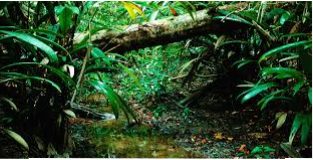Biogeochemical Consequences of Hydrologic Conditions in Isolated Stands of
Terminalia Cattapa in the Rainforest Zone of Southern Nigeria
Ndakara, O. E.
Department of Geography and Regional Planning, Delta State University, P.M.B.1 Abraka, Delta State, Nigeria.
ABSTRACT
Nutrient cycling is vital to the sustenance and productivity of trees and other plants. Farmers incorporate stands of
exotic trees into their farms to provide shade and fruits thereby, contributing to the rural economy. Despite the
importance of these isolated trees in the environment, the biogeochemical implications of hydrologic processes of
isolated exotics have not been adequately documented in southern Nigeria. This study examined biogeochemical
implications of hydrologic processes under isolated stands of Terminalia cattapa (T. cattapa) in Orogun, southern
Nigeria. Throughfall and stemflow were collected from 15 stands of T. cattapa between February 2010 and January
2011; while soil samples were collected underneath the trees. Throughfall and rainfall were collected with funneltype
collectors; stemflow was collected with ¾ mm hose wound round tree trunks; and soil samples collected with a
core sampler. Samples collected were analysed in the laboratory using standard methods. Data obtained were
statistically analysed with both descriptive and inferential techniques using the SPSS 15.0 version. Annual throughfall
and stemflow volumes were 89.2% and 6.5% of the incident rainfall (4325mm). Nitrogen, phosphorus and potassium
returned to the soil via throughfall and stemflow varied, with marked similarity between the isolated tree stands and
adjoining rainforest used as control. Potassium returned to the soil via throughfall in T. cattapa and rainforest were
62.5 kg/ha/yr and 65.4 kg/ha/yr; while the corresponding values for calcium were 30.6 kg/ha/yr and 31.3 kg/ha/yr.
More nutrients were returned via throughfall between November and March while peak nutrient returns via
stemflow occurred between May and October. Soil nutrients (N, P, K) correlated with throughfall and stemflow at r ≥
0.23 and r ≥0.45 respectively. The isolated exotic tree stands were not observed to deplete soil nutrients. Their
gradual returns of nutrient elements to the soil through hydrologic processes overtime help to improve soil nutrient
status in the rainforest ecosystem.
Key words: Biogeochemical cycling, hydrologic processes, nutrient fluxes, Rainforest ecosystem, Southern Nigeria, Terminalia cattapa.
Click here to read more

